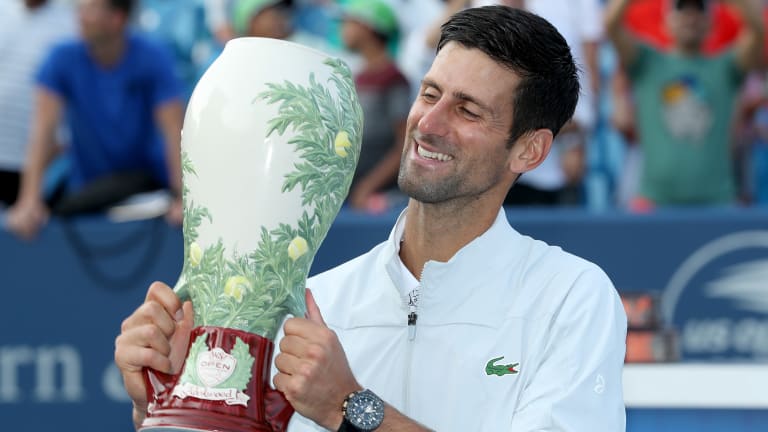“Vintage” and “master class” are terms that are usually reserved for performances by Roger Federer. But they were both apt descriptions of Novak Djokovic’s 6-4, 6-4 win over Federer in the Cincinnati final on Sunday.
From the start, this was the Djokovic of old—sliding, defending, counter-punching, keeping his passing shots low, his returns deep, his crosscourt forehand heavy and his down-the-line backhand in the corners. The old, trademark, Djokovic sneaker squeak could be heard on American hard courts again.
Federer hadn’t been broken on these courts since 2013, but Djokovic nearly ended that run in the very first game when he earned two break points. While Federer aced his way out of trouble, it was clear that Djokovic was seeing the ball well and hitting it cleanly. It was also clear that he was going to be a very different and more assertive player than the one we had seen so far in Cincinnati.
In his own opening service game, Djokovic unleashed a 102-m.p.h. second serve. Two games later, it was up to 105. Two games after that, he fired one in at 110; earlier in the tournament, his second-serve speeds had been in the 70s and 80s. That sudden change of pace may have had a major impact on this match, because Federer never found any rhythm on his return. In the standout stat of the day, Djokovic won 78 percent of his second-serve points.
Serving at 1-2, and 2-3, Djokovic held at love; and at 3-3, he finally cracked the code on Federer’s serve. The key, it seemed, was to make Federer whiff. That’s what the Maestro did on a forehand at break point; it was Federer’s eighth error from that wing in just seven games, and a miss so mortifying that he cursed the asphalt in front of him as he walked to the sidelines. Adding insult to injury for Federer—and helping buoy Djokovic—was the large, and very vocal, contingent of Serbian fans in the arena.
In the second set, Federer broke Djokovic to go up 2-0; but rather than the start of a comeback, it was only a brief and illusory respite—there would be no turnarounds today. Djokovic got right back to vintage business. He broke back by taking a Federer overhead with his forehand and putting the ball an inch inside the baseline. He held at love again for 2-2. And at 3-3, Djokovic threaded a forehand pass down the line for the match-deciding service break.
It was a service break that Federer will likely do his best to forget. Up 40-0, with the game seemingly in hand, he served-and-volleyed, and put a half-volley into the net. It proved to be a costly choice, and miss, as the game and the match quickly spiraled out of his control. While Djokovic looked a little nervous trying to close it out over the last three games, Federer couldn’t keep the ball in play long enough to apply any real pressure.
